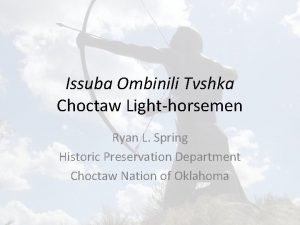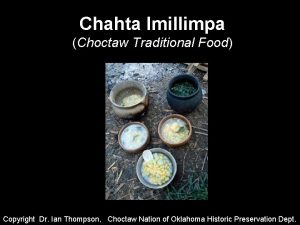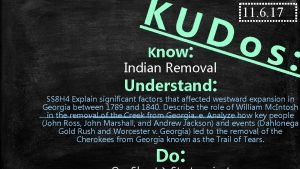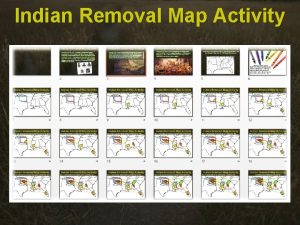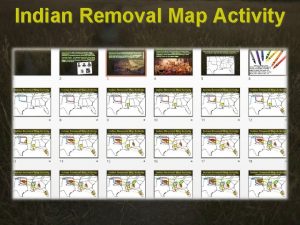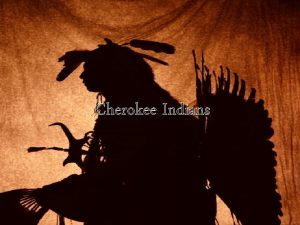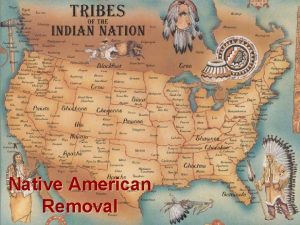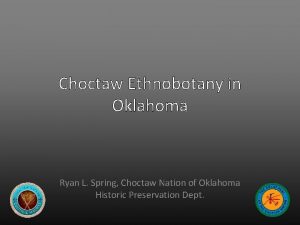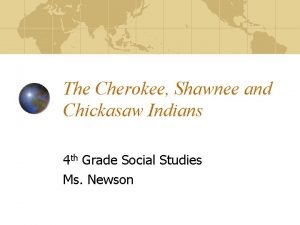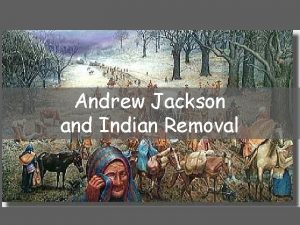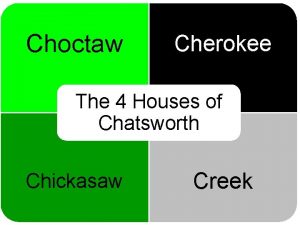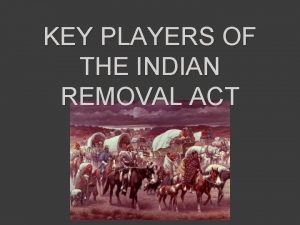INDIAN REMOVAL Whites called the Cherokee Chickasaw Choctaw














- Slides: 14

INDIAN REMOVAL

Whites called the Cherokee, Chickasaw, Choctaw, Creek and Seminole the five civilized tribes because they had adopted many aspects of white culture. 1

In 1791 the U. S. Government signed the Treaty of Holston with the Cherokee Nation. With this treaty the U. S. government officially recognized the Cherokee Nation, covering ten million acres of land in present-day Georgia. 2

The Creek War (1813– 1814), also known as the Red Stick War and the Creek Civil War, began as a civil war within the Creek (Muscogee) nation. United States forces became involved by attacking a Creek party in present-day southern Alabama at the Battle of Burnt Corn. The war ended after General Andrew Jackson in command of a force of combined state militias, Lower Creek and Cherokee defeated the Red Sticks at Horseshoe Bend. This led to the Treaty of Fort Jackson (August 1814) where the general insisted on the Creek ceding more than 21 million acres of land from southern Georgia and central Alabama. These lands were taken from the allied Lower Creek as well as the defeated Upper Creek. 3

86 character writing system for the Cherokee language. In 1821 Sequoya invented a writing system for the Cherokee. He hoped his people could share the power of whites and keep their independence. 4

In 1827 the Cherokee Nation wrote a constitution outlining the manner in which it would govern itself. Drawn up by a convention led by Chief John Ross, the constitution represented a bold declaration of Cherokee independence—though, ironically, it drew heavily from the Constitution of the United States for inspiration. This, and the fact that it was published in both English and the Cherokee language in a Cherokee newspaper, demonstrated the willingness and capacity of Cherokees to adopt aspects of white civilization. We the Representatives of the people of the Cherokee Nation , in Convention assembled in order to establish justice ensure tranquility, promote our common welfare, and secure to ourselves and our posterity the blessings of liberty acknowledging with humility and gratitude the goodness of the sovereign ruler of the Universe affording us an opportunity so favorable to the design and imploring his aid and direction in its accomplishments do ordain and establish this Constitution for the Government of the Cherokee Nation. The preamble to the Cherokee constitution. 5

In 1828 Andrew Jackson was elected to the presidency and gold was discovered in Georgia. 6

In 1830 Congress passed the Indian Removal Act, calling for one hundred thousand Indians to be transported west of the Mississippi River from their homes in the East. President Jackson thought this policy was “just and liberal. ” 7

A peaceful people, occupying the Mississippi Valley and parts of Alabama, the Choctaw saw economic opportunities and sold goods and livestock to the Europeans who ventured into their territory. Between 1801 and 1830, the Choctaw made a series of treaties with the U. S. government, ceding 23 million acres of land. They were forced to relocate to Indian Territory (present-day Oklahoma) in 1832. 8

The Cherokee appealed to the U. S. Supreme Court to keep their land. In 1832 Chief Justice John Marshall ruled in favor of the Cherokee. President Jackson ignored the Supreme Court. Chief Justice John Marshall 9

John Ross Chief of the Cherokee John Ridge Leader of the Treaty Party The Treaty of New Echota was signed on December 29, 1835, in New Echota, Georgia by officials of the United States government and representatives of a minority Cherokee political faction, the Treaty Party, led by John Ridge. The treaty was amended and ratified by the US Senate in March 1836. The Cherokee National Council angrily disputed the treaty because it was not signed by their principal chief, John Ross. 10

In 1837 Martin Van Buren, who served as vice president to Andrew Jackson, became the 8 th president of the United States of America. In keeping with Jackson’s removal policy Van Buren ordered federal troops to force about 16, 000 Cherokee from their homes. They were then put in prison camps where they waited until all of the Cherokee were rounded up. 11

Over the fall and winter of 1838 the 16, 000 Cherokee were forced to walk more than 1200 miles in the cold, rain and snow to Indian Territory. Approximately 4, 000 died along the way. This event later became know as the Trail of Tears. 12

The Treaty of Payne's Landing, signed by a small number of Seminoles in May 1832, required Indians to give up their Florida lands within three years and move west. When the U. S. Army arrived in 1835 to enforce the treaty, the Indians were ready for war. The campaigns of the Second Seminole War were an outstanding demonstration of guerrilla warfare by the Seminole. As Major Francis Dade marched from Fort Brooke toward Fort King, 180 Seminole warriors attacked. Only one man of that army detachment survived the ambush. The Second Seminole War (1835 -1842), was the fiercest war waged by the U. S. government against American Indians. The United States spent more than $20 million fighting the Seminoles. The war left more than 1, 500 soldiers and uncounted American civilians dead. In 1842, a nominal end to the hostilities arrived, though no peace treaty was ever signed. By this time most Seminoles had been moved from Florida, relocated to Indian Territory which is known today as Oklahoma. 13
 Brain wrinkles
Brain wrinkles Choctaw lighthorsemen
Choctaw lighthorsemen Traditional choctaw food
Traditional choctaw food Chickasaw nation department of health
Chickasaw nation department of health Chickasaw nation industries inc
Chickasaw nation industries inc Chickasaw city schools
Chickasaw city schools The plains indians were finally forced to surrender
The plains indians were finally forced to surrender Quiz
Quiz Indian removal act
Indian removal act Indian removal act of 1830
Indian removal act of 1830 Indian removal map activity
Indian removal map activity Indian removal map activity
Indian removal map activity Indian removal act of 1830
Indian removal act of 1830 Cellular waste removal
Cellular waste removal Cherokee wedding prayer
Cherokee wedding prayer

